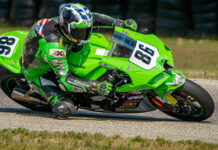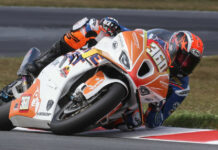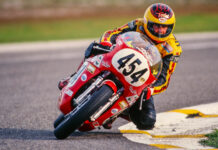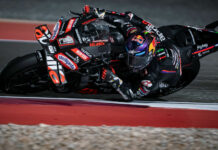DUCATI PANIGALE V4 R
The Panigale V4 R is the ultimate road-legal Ducati race bike. Compared to the previous Rversion, the Panigale V4 R is even more specialized. The modifications extend far beyond the engine and suspension set-up: for the first time they also include an Aero Pack designed directly by Ducati Corse in close collaboration with the Ducati Style Centre to improve on-track aerodynamic efficiency.
The Panigale V4 R is a road-legal WSBK category racing bike and constitutes the technical platform for the official Ducati Superbikes that will compete in the 2019 season. The new Panigale V4 R merges the essence of the Panigale V4 S with the specific changes requested by Ducati Corse to make it race-competitive. The 1,103 cm3 90° V4 engine has been replaced with the 998 cm3 Desmosedici Stradale R which brings it within the displacement limits established by WSBK championship rules. The bike features a new fairing incorporating wings elements of MotoGP origin. It also has race-grade Öhlins suspension with mechanical adjustment and an aluminum swingarm with an adjustable four-position pin. Moreover, the Front Frame has been modified to achieve the stiffness targets set by Ducati Corse. Sophisticated electronic controls borrowed from the Panigale V4 S now have revised threshold levels to make them more compatible with pro rider requirements.

(Above) Ducati CEO Claudio Domenicali with the 2019 Ducati Panigale V4 R.
Unlike the 1,103 cm3 Desmosedici Stradale, designed to provide fluid power delivery and excellent low-rev pulling power for optimal road use, the 998 cm3 Desmosedici Stradale R version offers more extreme performance as power delivery has been designed with the track in mind. The Desmosedici Stradale R features lighter internal components and greater air intake efficiency: this allows faster engine rev-up and shifts the rpm red zone higher to improve acceleration. The result is 221 hp (162 kW) of power – which responds instantaneously to throttle movements – at 15,250 rpm (EU homologation values), 2,250 rpm higher than on the 1,103 cm3 V4.
It’s not just the racing-inspired livery that makes the Panigale V4 R unmistakable. An eye-catching aerodynamics package requested by Ducati Corse includes screen, nose fairing and side fairings to reduce drag. It also features specially shaped air vents to keep things cool during intense racing use. GP16-derived carbon fiber wings augment stability at all times, reducing electronic control intervention and boosting rider confidence, helping him keep the throttle open longer and brake later going into the bends.
The suspension system has been optimized for track use. Both the steering damper and the Öhlins suspension mount mechanically adjustable top-drawer components. More specifically, the brand new pressurized NPX 25/30 front forks take as-standard Öhlins components to new heights. The rear TTX36 shock absorber completes the package.
Ducati Panigale V4 R
- ·Colour
- –“R” livery with aluminium tank
- ·Main as-standard features:
- –90° Desmosedici Stradale V4, R version, 998 cm3, 221 hp (162 kW) at 15,250 rpm
- –Forged steel crankshaft with reduced stroke
- –Molded aluminum pistons with single compression ring plus oil ring
- –Titanium con rods
- –Titanium intake valves
- –Oval throttle bodies (Ø 56 mm equivalent) and aerodynamic throttle openings
- –Dedicated variable-height air intake horns
- –Exhaust manifolds of optimised length
- –Cylinder heads with larger intake ducts
- –High-permeability Sprintfilter P08 air filter
- –Lightened, optimized-stiffness aluminum alloy Front Frame
- –Pressurized Öhlins NPX 25-30 forks with manual adjustment
- –Öhlins TTX36 shock absorber with manual adjustment
- –Öhlins steering damper with manual adjustment
- –Single-sided aluminum swingarm with adjustable pivot height (4 positions)
- –Total Black Marchesini forged aluminum wheels
- –Pirelli Diablo Supercorsa SP tyres (rear 200/60)
- –Braking system with Brembo Stylema® monobloc calipers
- –Aero Pack with carbon fiber wings
- –16-litre aluminum fuel tank with racing lay-out
- –Carbon fibre front mudguard
- –Carbon fiber rear manifold heat guard
- –Dedicated seat
- –15/42 final transmission with 520 chain
- –Full-TFT 5” screen
- –Riding Modes (Race, Sport, Street)
- –Electronics package with 6-axis Inertial Measurement Unit (6D IMU) including: ABS Cornering Bosch EVO; Ducati Traction Control EVO (DTC) EVO; Ducati Slide Control (DSC); Ducati Wheelie Control EVO (DWC) EVO; Ducati Power Launch (DPL); Ducati Quick Shift up/down EVO (DQS) EVO; Engine Brake Control EVO (EBC) EVO.
- –Pit Limiter
- –Lap Timer EVO
- –Keys for fast selection of controls
- –Ducati Multimedia System (DMS)
- –Full-LED headlight with DRL
- –Single-seater configuration
- –Ducati Data Analyzer (DDA+) with GPS module
- –Lithium-ion battery
- –Supplied: aluminum mirror hole covers, plate holder removal kit

(Above) A pair of Ducati Panigale V4 R models on track.
Desmosedici Stradale R engine
The Desmosedici Stradale R – the link between the 1,103 cm3 V4 on the Panigale V4 and the MotoGP engine – takes the performance limits for a road-legal engine to unprecedented heights. Originally designed to compete in the Superbike championships, this engine has now undergone numerous changes that make it even more like the one used in MotoGP.
The Panigale V4 R engine can deliver 221 hp (162 kW) at 15,250 rpm and 112 Nm of torque at 11,500 rpm (EU homologation values). It has a 14:1 compression ratio and the rev limiter is set at 16,000 rpm (16,500 rpm in sixth gear). These figures – impressive for a 998 cm3 engine – can be taken even higher by fitting the full-racing Ducati Performance exhaust by Akrapovic, which boosts maximum power to 234 hp (172 kW) at 15,500 rpm.
Like the Desmosedici Stradale, the R version is a 90° V4 with cylinders banked 42° back from the horizontal, a Twin Pulse firing order and a counter-rotating crankshaft*. Designed to be a fully stressed member of the vehicle, the engine retains a bore of 81 mm while stroke has been increased to 48.4 mm thanks to the new forged steel crankshaft which moves four titanium con rods with a center-to-center of 104.3 mm: each one is 100 g lighter than the steel ones used on the Panigale V4.
Pistons are made of molded aluminum, have a single compression ring plus an oil ring and take advantage of “box in box” technology: this contains both skirt height and below-chamber thickness, helping to reduce attrition and inertial loads while maintaining the necessary strength and stiffness.
Featuring dedicated profiles, the four Desmosedici Stradale R camshafts provide increased lift with respect to the Desmosedici Stradale and move the sixteen valves (Ø 34 mm titanium intake valves, Ø 27.5 mm steel exhaust valves). The valves feature titanium half-cones, a solution usually adopted only on racing bikes. Dedicated fluid dynamic design of the R engine cylinder heads has led to the development of new, larger intake ducts.
The new crankshaft – 1,100 grams lighter than the one on the Panigale V4 – is mounted on brass bushings and retains the 70° crank pin offset together with the 90-degree V engine layout. This solution generates what Ducati calls a Twin Pulse firing order, because it’s as if the engine were reproducing the firing sequence of a twin-cylinder. The distinctiveness lies in the fact that the two left-hand cylinders fire closely together, as do the two right-hand ones. On the timing chart, the ignition points are, then, at 0°, 90°, 290° and 380°. This particular firing order makes the V4 sound just like the MotoGP Desmosedici.
The Desmosedici Stradale R engine gulps in air through oval throttle bodies and aerodynamic throttle openings (Ø 56 mm equivalent, an increase of 4 mm) connected to variable-height air intake horns of dedicated length. This solution optimizes cylinder intake across the rev range, giving major advantages in terms of power delivery and handling. The R engine breathes through a high-permeability Sprintfilter P08 air filter.
Thanks to development in close collaboration with Ducati Corse, the R version of the Desmosedici Stradale engine has undergone numerous performance-enhancing improvements. To limit power absorption the oil delivery pump has been redesigned and the alternator rotor lightened, shaving another 100 grams off total bike weight.
* However, in racing, there’s no such thing as a free lunch: this layout demands, of course, the addition of the so-called ‘jackshaft’ to transfer crankshaft drive through the gearbox to the rear wheel so it turns the right way. The jackshaft adds an extra transmission element to the crankshaft-wheel connection system. This needs to be taken into consideration when establishing crankshaft power if the latter is obtained from measurements made at the wheel. During both homologation and measurement on acceleration test benches it is, therefore, necessary to consider an efficiency or, in any case, an additional coefficient that is, by law, fixed at 0.98.
Aero Pack by Ducati Corse
The aerodynamic Panigale V4 R ‘shell’ was developed by Ducati Corse in close collaboration with the Ducati Style Centre; the outcome is a fairing in true Panigale style that meets official Ducati Superbike needs in full.
As in MotoGP, aerodynamic development involved a series of preliminary CFD (Computational Fluid Dynamics) studies, followed by optimized shaping and a full-scale wind tunnel model.
The Panigale V4 R aerodynamics package includes:
- ·Screen, nose fairing and larger lateral fairings
- ·More efficient lateral vents for radiator through-air
- ·Wings
Compared to the Panigale V4, the new screen – higher and more angled – provides better airflow protection for riders, especially in the helmet and upper shoulder areas. The screen is attached to a new nose fairing that is higher and wider (+15 mm per side) in the arm-shield zone in order to reduce arm and shoulder-induced drag on the straights.
The lateral fairings have been widened considerably (+38 mm per side) with the dual aim of reducing on-rider airflow impact and maximizing aerofoil efficiency.
At the sides, the stylish air vents of the Panigale V4 have been replaced by more efficient ones designed to handle the racing-type temperatures reached by the more powerful engine on the Ducati Panigale V4 R. These new vents increase air through-speeds on water and oil radiators by 6% and 16% respectively.
The biggest change on the Panigale V4 R – which defines the aesthetics of the bike – comes from the wings. Conceptually derived from those used on the GP16 (before foil shapes were subject to regulatory limits), the wings on the Panigale V4 R are actually more efficient than those employed in MotoGP.
These monoplane single-element wings have a trapezoidal layout with a tapered profile from root to tip. Wing performance has been improved thanks to the insertion of the longitudinally arranged strake and the winglet which ‘insulates’ the airflow over its surfaces.
Working in concert with the fairing design, the wings increase overall downforce (+30 kg at 270 kph). Greater downforce reduces front wheel ‘floating’ at high speed and the tendency to wheel-up; it also boosts stability during braking at the turn-in point and through the corner.
This dynamic behavior lets riders – against a small increase in steering torque caused by the heightened stability – lower their lap times as it reduces electronic control intervention, helping riders keep the throttle open for longer and brake later, even when cornering has already begun.
Race-optimized chassis set-up
Frame
The Panigale V4 R Front Frame differs from the V4 S one not just because it is black. Above all, its lighter, machined sides ensure attainment of the stiffness goals set by Ducati Corse and reduce weight even further. To complete the modifications to the chassis set-up, the rear swingarm pivot height can now be adjusted (it has 4 positions, 2 mm apart from each other). This pivot broadens the adjustment scope so the bike can be adapted more precisely to individual riding styles and road/track conditions.
Suspension
Since the Panigale V4 R has been designed for near-exclusive use on race tracks, it does not mount the event-based semi-active Öhlins suspension seen on the V4 S but, rather, the Swedish firm’s professional mechanical units.
Up front, the Panigale V4 R mounts an exclusive new pressurized Öhlins 43 mm NPX 25/30 fork with TiN treatment and, at the rear, an Öhlins TTX36 shock absorber. Both feature mechanical adjustment. The Öhlins steering damper also abandons electronic adjustment in favor of a mechanical alternative.
Compared to the NIX 30 model on the Panigale V4 S, the new NPX 25/30 uses a pressurized damping system that is an offshoot of the one used on Öhlins WSB racing forks. Compared to a traditional system, a pressurized one minimizes the risk of oil cavitation, offering improved absorption of bumps, pits and ripples while ensuring excellent braking stability and support to give the rider better front-end ‘feel’.
Just like the Öhlins forks used in MotoGP, compression damping occurs in the left fork tube and makes use of a Ø 25 mm piston. Rebound damping instead, in the right fork tube, uses a Ø 30 mm one. Specifically designed and machined fork bodies save a further 600 g with respect to the forks on the Panigale V4 S.
To complete the suspension set-up the bike features the same ‘total black’ aluminum Marchesini wheels used on official Ducati bikes.
Electronics
Latest-generation electronic controls
The Panigale V4 R is equipped with a latest-generation electronics package that controls every stage of the ride via a 6-axis Bosch inertial platform (6D IMU – Inertial Measurement Unit). The latter features revised intervention logic to adapt to the needs of pro riders.
The Panigale V4 R electronic control package includes:
·Bosch Cornering ABS EVO
·Ducati Traction Control EVO (DTC) EVO
·Ducati Slide Control (DSC)
·Ducati Wheelie Control EVO (DWC) EVO
·Ducati Power Launch (DPL)
·Ducati Quick Shift up/down EVO (DQS) EVO
·Engine Brake Control EVO (EBC) EVO
The operational parameters for each of these controls are associated by default with the three Panigale V4 R Riding Modes. DTC, DWC, DSC or EBC control levels can be adjusted quickly via the left switchgear.
Bosch Cornering ABS EVO
The Bosch ABS system with Cornering function allows ABS operation even with the bike leaned over. Bosch Cornering ABS EVO can be set at three different levels to fully satisfy the needs of all riders.
While level 3 is recommended for low-grip conditions, levels 2 and 1 emphasize braking power and are intended for use on high-grip surfaces.
Selecting level 2 activates the Slide by Brake function, which lets riders drift the bike into the corners safely.
Recommended for pro riders, ABS level 1 restricts ABS intervention to the front brake only, yet retains the Cornering function to allow super-hard braking up to and past the turn-in and recovery from any riding errors.
Ducati Traction Control EVO (DTC) EVO
The DTC EVO interfaces with the 6-axis Inertial Measurement Unit (IMU), constantly measuring the lean angle and using it to accurately calculate the degree of intervention needed to ensure suitable rear wheelspin (according to the DTC EVO level setting).
When set to level 1 or 2, DTC EVO activates the Spin on Demand function. This lets the rider use the throttle, with the bike leaned over, to request more wheelspin than would be given by the normal intervention level so the bike can pivot around its front wheel and complete the taken cornering line.
DTC EVO acts not just on ignition and injection advance but also on throttle body valve aperture to ensure more fluid intervention when fast-action control is not required.
Ducati Slide Control (DSC)
Co-developed with Ducati Corse, this new system provides the rider with further support by controlling the torque delivered by the engine as a function of the slide angle; its goal is to improve out-of-the-corner performance by preventing slide angles that might otherwise be difficult to handle.
DSC has two different settings: switching from level 1 to level 2 results in easier control of slide angles that would otherwise be hard to manage.
Like DTC EVO, DSC controls torque reduction by acting on the throttle body valves, decreasing spark advance and reducing injection.
Ducati Wheelie Control EVO (DWC) EVO
The Panigale V4 R is also equipped with the latest version of Ducati Wheelie Control EVO (DWC EVO). Thanks to the information provided by the IMU 6D, DWC EVO provides more accurate wheelie readings; it thus exerts more precise control so the bike responds faster to rider input.
Ducati Power Launch (DPL)
This 3-level system ensures lightning-fast yet safe starts, letting the rider focus on releasing the clutch. The DPL makes use of the DWC functions and always keeps DTC active to ensure compete safety at all times
The DPL has three different settings and is activated by pressing the specific key on the right-hand switchgear. Level 1 favors high-performance starts, level 3 is safer and more stable.
Ducati Quick Shift up/down EVO (DQS) EVO
In addition to minimizing shift times, the DQS EVO with up/down function allows clutchless down-changes. The EVO version mounted on the V4 R uses lean angle info to maximize bike stability during through-the-corner gearshifts.During downshifting this system works seamlessly with the slipper clutch and Engine Brake Control (EBC) to ensure optimal gear meshing during on-the-edge riding.
Engine Brake Control EVO (EBC) EVO
EBC (Engine Brake Control) helps riders optimize bike stability under extreme turn-in conditions. EBC EVO, optimized according to lean angle, monitors the throttle body valve position, the selected gear and crankshaft deceleration during aggressive braking and adjusts throttle aperture to balance out the torque applied to the tire.
New Ducati Riding Mode (RM) strategy
Riding Modes provide users with three different pre-set riding styles so that Panigale V4 R performance can be adapted to the rider, the nature of the track/route and weather conditions.
Race Riding Mode – Race RM is designed to let the rider tap into the full potential of the Panigale V4 R on high-grip asphalts. Selecting Race gives the rider 221 hp, with direct Ride-by-Wire throttle response. Race mode sets the electronics at a low intervention level: for example, to maximize braking performance the ABS kicks in on the front wheel only (but with the Cornering function always on).
Sport Riding Mode – Sport RM allows less experienced riders to enjoy effective, spectacular bike performance. Again, the engine delivers 221 hp but with a sports-style Ride-by-Wire throttle response. The Slide by Brake function is activated, as is Cornering ABS, to maximize cornering performance.
Street Riding Mode – Street RM is recommended when riding the Panigale V4 R on low-grip surfaces or the public highway. This RM still delivers 221 hp but, like Sport RM, has a more progressive throttle response. Electronic control settings ensure grip and stability to maximize safety.
TFT Instrumentation
The Panigale V4 R uses the same cutting-edge, high resolution 5″ full-TFT color display (186.59 PPI – 800xRGBx480) as the Panigale V4. Graphics have been revised to reflect the introduction of new functions and the higher engine rev ‘red zone’.
The dashboard is dominated by the round virtual rev counter on the right. Desmosedici Stradale R revs are displayed within a 1,000-16,500 rpm interval by a needle gauge. Movement of the latter is accompanied by a white trail that acts as a ‘shift light’, changing color from white to orange and then red as the rev limit approaches.
The rider can call up two different lay-outs: ‘Track’ highlights the lap times and the rev counter scale makes the revs used on the track more clearly visible; ‘Road’, instead, replaces lap times with info on the Ducati Multimedia System (DMS), where present, and the rev scale is more appropriate for road use.
Pit Limiter (PIT)
The Panigale V4 R sees the Pit Limiter make its debut. Once switched on (by pressing the relative key on the right-hand switchgear) it auto-limits bike speed in the pit lane. The speed limit can be set within the range shown on the menu (min. 40 kph, max. 80 kph).
Ducati Lap Timer GPS (DLT GPS)
The Panigale V4 R dashboard incorporates a lap timer that has more advanced functions than the one on the Panigale V4. The DLT GPS on the V4 R automatically detects not just lap times: it can also take two intermediate times and display them directly on the dashboard at every ride-past. If a lap time is the best of the current track session, the Best Lap function causes it to flash for 5 seconds. On every lap the system records not just the time but also maximum RPM, maximum speed (real, GPS-detected), intermediate times plus lean and yaw angles.
Ducati Data Analyzer + GPS (DDA+ GPS)
The Ducati Data Analyzer + GPS (DDA + GPS), allows assessment of bike and rider performance by showing traces for specific data items. DDA + GPS is a vital performance monitoring tool. Not only does it automatically display and record lap times, it also saves other data traces such as throttle opening, vehicle speed, engine rpm, selected gear, engine temperature, distance travelled and the DTC trace.
Ducati Multimedia System (DMS)
The Panigale V4 R can be fitted with the Ducati Multimedia System (DMS). This lets riders take incoming calls, select and listen to music tracks or receive text messages via a Bluetooth link.






